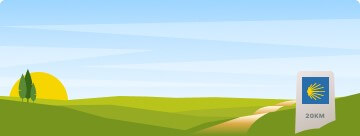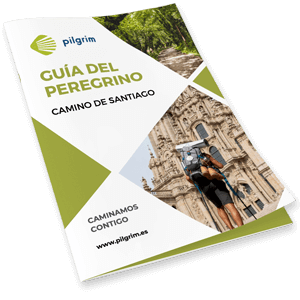How should I eat during the Camino?
If you’ve followed the recommended walking guidelines—gentle pace and frequent stops—you won’t need to drastically change your usual diet, as long as you include certain foods for extra energy.
Your diet and water intake will vary according to the chosen route, weather conditions, your pace, distance, and more. Most of the time, your body will ask for more water and energy, so it’s important to increase your intake of water, fruit, and nuts. Dehydration can lead to muscle strains, fatigue, and tension, so make sure your water bottle is always filled.
Although you burn more calories than normal, you should avoid extremely large meals because they’ll cause blood flow to center on your stomach, creating heaviness until the end of the stage. It’s best to have your main meal at the end of the stage to restore energy and fluids.
A recommended daily layout might be:
- Breakfast: It’s the most important meal of the day, so try to have it as complete as possible, including cereals, dairy, juice, and fruit.
- Mid-morning: During your walk, drink plenty of water and consume light, but energy-dense foods.
- Lunch: Often sandwiches or light dishes along the route.
- Dinner: Usually at the end of the stage, when you need to recharge for the next day with foods rich in salts and carbohydrates.
Should I stretch while walking? Walking tips.
It’s best if the first two or three stages don’t exceed 20 km; after that, you can increase distance based on age and fitness level. The average is usually around 22-25 km per day.
It’s also advisable to stop at least 10 minutes every 60-90 minutes to rehydrate, take photos, and do some leg and back stretches. At the beginning and end of each stage, devote more time to stretching—focusing at least on legs, back, lower back, and shoulders. This helps prevent common injuries, like tendonitis.
Start your day slowly to warm up your muscles. Once you’re warmed up, walk at a comfortable pace—one at which you can converse without difficulty. For uphill sections, shorten and slow your step, placing your entire foot on the ground. Downhill sections can be longer and faster if you feel comfortable.
Avoid the mistake of keeping pace with someone faster than you. Everyone has their own rhythm; going too fast can lead to fatigue or injury.
Where to eat?
Throughout the different Camino de Santiago routes, there are restaurants or bars where you can have meals. In most towns, you’ll also find dining options and grocery stores.
Depending on your budget or where you are in your stage, you’ll decide where to stop for food. If you’re between towns, a common practice is to buy sandwich ingredients beforehand at a supermarket. If you prefer a sit-down meal, many restaurants offer special pilgrim menus. Check our recommended establishments section for details.
Don’t forget to drink enough water on the way to avoid dehydration.
I’m lost, what do I do?
If you find yourself off-track, stay calm. You should know which towns the Camino passes through. Reaching them is straightforward thanks to waymarking that guides you back to the Jacobean path. You can also ask locals or other pilgrims.
In a last resort or if you’re in danger, call emergency services (112) as soon as possible.
I need medical assistance, what do I do?
In each town’s information sheet on the Camino, you’ll find phone numbers for health centers and hospitals. In more serious cases, call 112 so they can send an ambulance, or contact us directly.
If you experience any muscle injury or discomfort while walking, Pilgrim has a network of physiotherapists along the Camino to help with these issues.
I need vet assistance, what do I do?
If you’re traveling with your pet and it has an accident or sudden illness, contact us to find the nearest veterinary service. You can also check our town-by-town information in advance to prepare for such incidents.
Can I wash my clothes on the way?
Most public hostels—and to a lesser extent, other accommodations—offer laundry services so you can wash and dry your clothes during the Camino.
Once you reach Santiago de Compostela, Pilgrim gives you the option to do your laundry there, so you can return home with clean clothes.
Do I have to get up really early?
It’s common to see pilgrims starting before dawn, especially if they stay in public hostels to secure a bed.
Public hostels fill up on a first-come, first-served basis for pilgrims with a credential, giving priority to those on foot. You can only stay one night unless there’s a special circumstance. This is why many pilgrims rise early, aiming to finish their stage mid-morning, get a spot, and explore the area.
If you don’t plan on using public hostels, there’s no need to wake up too early—you can rest and then enjoy the stage without rushing.
However, in summer it’s wise to start somewhat earlier to avoid the midday heat and reduce the risk of heatstroke.
What can I visit in each town?
Pilgrim has selected the top points of interest for each stage and each town along the Jacobean routes. You can access these details in the Caminos section, and within each route’s specific towns and cities. This way, you can plan your stops according to the sights you’d like to see.
Other tips about the Camino
Find the best recommendations for walking the Camino de Santiago

